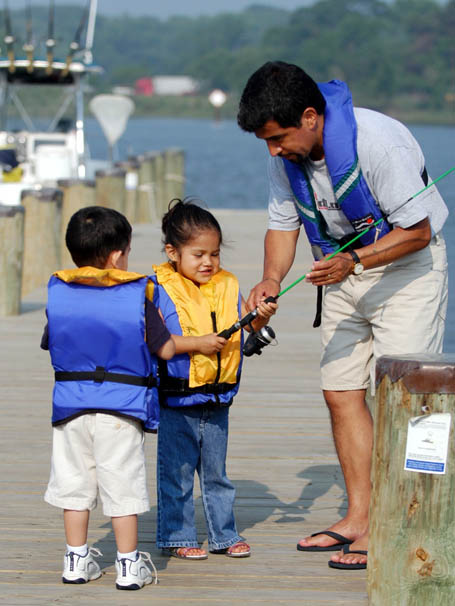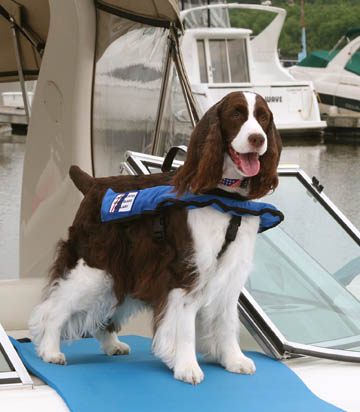
The Saltwater Magazine for Gulf Coast Fishing!
FISHING FORECASTS | FISHING CALENDARS | ARTICLES | ADVERTISE | SUBSCRIBE
Search Gulf Coast Fisherman's
Web Site
Past articles, specific
places or fish, etc.

New Life Jacket Technology
Integrates Safety and Lifestyle
by Marty Jackson
Lifesaving and Fire Safety Division
Office of Design and Engineering Standards
U.S.
Coast Guard

- Life jackets have come a long way from the canvas and cork vests of the 19th century, or the Mae West inflatables made famous in World War II. Thanks to new developments in technology, manufacturers now seamlessly integrate safety with lifestyle and sports, producing life jackets in a range of styles, materials, and easy-to-spot colors, and with features specifically designed for individual on-the-water activities. Think pockets for anglers, for example, or camouflage for waterfowl hunters.
For many boaters, what's most important about these newer life jackets is what they're not. They're not bulky. They're not hot. They don't restrict movement. Some won't even inhibit your golden tan. Plus there's been a revolution in sizing and fit. Designers are now offering life jackets for children and adults that fit a much broader range of weight and body types. In essence, by identifying comfort as a selling point for safety, manufacturers have maximized enjoyment while minimizing risk.
Looking ahead, boating equipment manufacturers and the U.S. Coast Guard are testing new technologies and products to further improve safety, including new auto-inflation systems and rescue harnesses for kayaks. Also, after successfully adapting LEDs (which burn a long time on very little power) for both interior and navigational lighting, manufacturers and the Coast Guard are working to adapt this same LED technology to emergency illumination devices. Used for life jacket lighting, for example, this technology could potentially make a person in the water at night visible for many, many hours, giving searchers more time to affect a rescue.
Day or night, the critical issue is surviving an accident, which on the water can happen with terrifying speed. If a boater isn't wearing a life jacket at the moment trouble strikes, chances are remote that he or she will have enough time to find one and put it on. That's a grim fact borne out each year in Coast Guard boating accident data. Despite federal requirements that boaters carry life jackets for everyone on board - and have all children under age 13 wearing a life jacket - some 90 percent of those who drown each year in boating accidents are not wearing them. These are lives that might have been saved with a bit more commitment to safety.
So with the start of a new boating season, consider how you can maximize enjoyment while minimizing risk for you and your passengers. Be safe. Make sure everyone on your boat wears a life jacket.
Know Your Type
Boaters unsure about which life jacket to purchase for their particular boating activity can download a brochure at www.uscgboating.org, under Boat Responsibly - Media and Marketing Materials. Before choosing a life jacket, however, make sure that it has a U.S. Coast Guard approval number. Life Jackets bearing this designation have undergone rigorous testing for effectiveness and durability, and meet the required standards for life-saving devices. Always check the label.
The five types of flotation devices for boaters are shown below:
Type I Offshore Life Jacket
Provides the most buoyancy and is effective for all waters, especially open, rough, or remote waters where rescue may be delayed. It is designed to turn most unconscious wearers to a face·up position in the water. Type I's are required on passenger for hire vessels like ferries and ocean liners. They are bulky and not commonly used by recreational boaters who stay relatively close to shore.
Type II Near-Shore Buoyancy Vests
Intended for calm, inland waterways or where there is a good chance of quick rescue. Inherently buoyant life jackets of this type will turn some unconscious wearers to a face-up position in the water, but the turning is not as pronounced as with a Type I. Children's life jackets typically fall into this category.
Type III Flotation Aid
Good for use in calm, inland water, or anywhere a quick rescue is likely. It is designed so that wearers can tilt their head back and remain in a face-up position in the water. Type IIIs come in many styles, colors, and sizes and are generally the most comfortable type for continuous wear. Float coats, life vests, and vests designed with features suitable for various water sports, including hunting and fishing, are examples of this type.
Type IV Throwable Devices
Intended for use anywhere. These are designed to be thrown to a person in the water and grasped and held by the user until rescued. They are not designed to be worn. Type IV throwable devices, which are required on all boats more than 16 feet in length, include buoyant cushions, ring buoys, and horseshoe buoys.
Type V Special Use
Intended for specific activities, these may be carried and used according to the condition(s) for which it is approved. If the label says the life jacket is "approved only when worn," the life jacket must be worn (except by persons in enclosed spaces) and used in accordance with the approval label to meet carriage requirements. Varieties include deck suits, exposure suits, work vests, board sailing vests, and vests with a safety harness. Some Type V devices provide significant hypothermia protection.
 Life Jackets for Dogs
Life Jackets for Dogs
Popular among boaters who want to take their pets along, these come in many styles, including foam and inflatable. The U.S. Coast Guard encourages safety precautions for all on board, including pets. Boaters who purchase a life jacket for their dog should check with the manufacturer for information about use, size, and fit.
And Wear It at All Times
A comfortable life jacket is more likely to be worn, and a life jacket worn at all times on or near the water is most likely to save a life. The newest to address the comfort issue include super lightweight flotation devices that inflate only when needed and life jackets that assimilate flexible Neoprene synthetic rubber and high-tech breathable fabrics into the manufacture. In addition, pillows that inflate are built into many full-body, insulated survival suits to help keep the boater's head out of the water and help avert hypothermia in cold water.
Whether foam, inflatable, or a hybrid of the two, the important thing is to pick a comfortable life jacket appropriate to your purpose and activity, as well as to the temperature of the air and water. For example:
o Hunting: Use a Type V coat or coverall that provides warmth and floatation.
o Paddling: Use a Type III or V vest that allows easy movement of the arms during paddling.
o Fishing: Use a Type III fishing vest that has pockets for fishing gear and allows easy movement of the arms for casting and reeling.
o Personal Watercraft and Water Sports: Use a Type III or V vest rated for high impact.
o General Recreational Boating: Pick a life jacket
that's appropriate to the air and water temperature. Consider auto-inflatables
only for passengers that can swim and are over 16 years of age.
# # #
The U.S. Coast Guard is asking all boat owners and operators to help reduce fatalities, injuries, property damages, and associated healthcare costs related to recreational boating accidents by taking personal responsibility for their own safety and the safety of their passengers. The U.S. Coast Guard reminds all boaters to "Boat Responsibly!" For more information and tips on boating safety, visit www.uscgboating.org.
